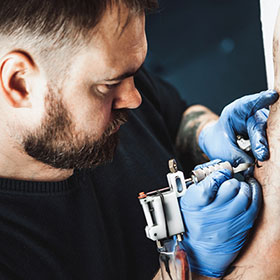Tattoos fade over time due to various factors. These include sun exposure, skin aging, and ink quality.
Tattoos are a popular form of self-expression and body art. Yet, many people notice their tattoos losing vibrancy as years pass. This fading can be disappointing, especially for those who cherish their ink. Understanding why tattoos fade can help in taking steps to maintain their appearance.
Several factors contribute to this issue. These range from external elements like UV rays to internal factors such as skin regeneration. Knowing these reasons is key to prolonging the life and beauty of your tattoos. In this blog, we will explore the main causes of tattoo fading and how you can combat them. Let’s dive into the details.
Tattoo Ink Composition
The ink in tattoos contains pigments and a carrier. Pigments add color to the tattoo. They come from various sources, like plants or minerals. The carrier helps the pigment go into the skin. It’s usually made of alcohol or water. Both ingredients play a role in how the tattoo looks over time.
High-quality pigments last longer. Cheap pigments fade fast. Quality pigments resist UV light better. They also stay bright and clear. Poor pigments can break down in the skin. This causes the tattoo to lose its sharpness. Always choose a reputable tattoo artist for the best results.
Skin’s Role In Tattoo Longevity
The skin has three main layers. These are the epidermis, dermis, and subcutaneous layer. Tattoo ink is placed in the dermis. The dermis is the middle layer of the skin. This layer holds the ink in place. The outer layer, the epidermis, sheds regularly. This can make tattoos appear faded over time.
Our skin cells constantly regenerate. New cells push old cells to the surface. These old cells then shed away. Cell regeneration helps heal skin but affects tattoos. As cells regenerate, some ink particles are lost. This process is natural and ongoing. It is a key reason why tattoos fade. Proper care can slow this process but not stop it completely.
Impact Of Sun Exposure
UV rays from the sun can harm your tattoo. These rays break down the ink. Your tattoo fades over time. The colors lose their brightness. Black ink turns gray. Colored inks turn dull.
Wear sunscreen with high SPF. Cover your tattoo with clothing. Avoid staying out in the sun too long. Stay in the shade when possible. Keep your skin moisturized. Hydrated skin holds ink better. Follow these tips to keep your tattoo bright.
Tattoo Placement Matters
Tattoos on some body parts fade faster. Hands and feet are examples. These areas see a lot of sun and wear. Sunlight can bleach the ink. Skin here also sheds more often. This makes the tattoo fade quickly.
Areas with much movement can cause tattoos to fade. Elbows and knees bend often. This constant motion wears down the ink. Clothing rubbing against the skin can also cause friction. This friction can make the tattoo lose its sharpness over time.
Importance Of Aftercare
The healing process is crucial for tattoos. Proper care helps the skin heal well. Good healing keeps the tattoo bright and sharp. Avoid touching the tattoo with dirty hands. Clean the tattoo gently with mild soap. Do not scratch or pick at the tattoo. Scratching can cause damage and lead to fading. Wear loose clothing to avoid friction. Friction can also cause fading. Protect the tattoo from the sun. UV rays can fade the colors quickly.
Moisturizing the tattoo is very important. Dry skin can cause the tattoo to crack. Cracks can lead to fading. Use a fragrance-free lotion. Fragrance can irritate the skin. Apply lotion gently. Do not overapply. Too much lotion can clog pores. Keep the skin hydrated. Drink plenty of water. Hydrated skin heals better and keeps the tattoo vibrant.
Influence Of Tattoo Technique
The skill of the artist matters a lot. An experienced artist uses better techniques. They ensure ink goes deep enough. This helps the tattoo last longer. A skilled artist knows how to handle the needle. They make sure the design stays sharp.
Needle depth is crucial. If the needle goes too shallow, the ink won’t stay. It fades faster. If it goes too deep, it can cause scarring. The perfect depth ensures the tattoo looks great. It also helps it last longer.
Effects Of Aging On Tattoos
As people age, skin loses its elasticity. This means the skin becomes less stretchy. Tattoos can stretch and lose their shape. Lines may look less sharp. Colors may blur. This is because the skin sags and wrinkles. Older skin does not hold ink as well. This makes tattoos look faded.
Over time, tattoo colors can change. Sun exposure can fade colors. UV rays break down the ink. Some colors fade faster than others. For example, red and yellow often fade quickly. Black ink usually lasts longer. But it can still look dull. Skin tone changes with age too. This can affect how the tattoo looks. The tattoo may not stand out as much. It may blend more with the skin.
Tattoo Touch-up And Maintenance
Tattoos may need a touch-up after a few years. Colors can fade, and lines may blur. A fresh touch can make them look new again. It’s best to consult your tattoo artist. They know the best time for a retouch. Regular check-ups help keep tattoos vibrant. Proper care also reduces fading.
Good care helps tattoos last long. Keep your skin moisturized. Dry skin can cause fading. Use sunscreen to protect tattoos from the sun. Avoid long baths and swimming pools. Chlorine can fade the ink. Regular care keeps tattoos looking their best.
Conclusion
Tattoo fading is a natural process. Sun exposure speeds it up. Skin changes and aging also play a role. Quality of ink matters too. Follow aftercare tips to keep tattoos vibrant. Protect your skin from the sun. Moisturize regularly. Choose a reputable tattoo artist.
These steps help maintain tattoo longevity. Enjoy your body art for years to come.

